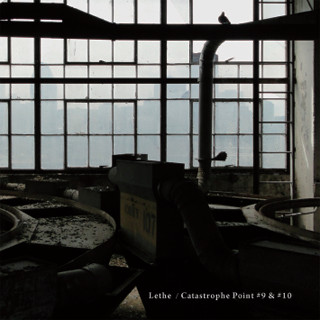
 |
|
 |
Format: do-CD Label & Cat.Number: ORAL - oral 56 Release Year: 2013 Note: "exploring the mysterious atmosphere of disused urban sites" - works Nr. 9 & 10 in this series were recorded in a huge silo & a long time closed tunnel in Montreal => pure acoustic, full reverberating & often metal object-based soundscapes, reminds on ORGANUM, YOSHI WADA, TOSHIYA TSUNODA, Z'EV...
Price (incl. 19% VAT): €24.00 Warning: Currently we do not have this album in stock!
More Info"Catastrophe point #9 & #10 are the latest in Kiyoharu Kuwayama's signature series of compositions that explore the charged, mysterious atmosphere of disused urban sites. For this double album, Lethe brought his attention to two Montreal known sites, the huge Silo no5 in Montreal port, and a long time closed tunnel in the southwest part of the city. Invited in residency in Montreal by the organization Minute in June 2012, Kiyoharu spent most of his days recording his musical actions in these really strong architectures, working with their sonic qualities and with found objects on these locations. Three panel jacket with 2 CDs. On ORAL_records, after releases on Cloud of Statics, Intransitive Recordings, Invisible Birds, Locust Music For those who like Toshiya Tsunoda, Z'ev, Organum, Christoph Heemann, Yoshi Wada CD 1: Catastrophe Point #9, sound materials recorded at Silo no. 5, Montreal, Canada June 24th, 2012. CD 2: Catastrophe Point #10, sound materials recorded at Closed Tunnel, Montreal, Canada June 19th, 20th, 2012. Notes by Kiyoharu Kuwayama : The place selected for #9 is a huge abandoned building in the port of Montreal. Silo no.5 began to be built in 1906 and is unused since 1996. 'Artist Emmanuel Madan of The User who has created a permanent sound installation in the port of Montreal connected to it invited me for a sound exploration. I recorded on the upper floor of this grain elevator. Despite the fact there was no reverberant sound peculiar in that room, a long reverberation was obtained by installing a microphone in one of the silos. At the time of recording, since reverberation itself could not be heard at all, it was difficult for me to anticipate the final recorded sounds. Objects to produce sounds were only a few in that space, only some metal sheets and rubber detritus. These conditions were a total new experience in the Catastrophe Point Series. 10 was recorded in a long time closed tunnel, which was built in 1931 to go under the Lachine canal, southwest of Montreal. I went a few times, during very hot days but in the deepest part of the tunnel it was so cold my breathing was producing some 'white smoke'. Because of a curve in its architecture daylight did not penetrate inside the tunnel, so I recorded lit only by a candle. My work is classified electroacoustic or field recording. I think field recording is not so important for these works, it is just one kind of method, there is no essence to it. No electronic treatments at all." [label info]www.oral.qc.ca "Rather than being a composer of music, or someone who does field recordings, or someone who builds installation pieces, Kiyoharu Kuwayama, also known as Lethe, is a man who creates site specific music. For him the space in which he is to create music is as important as anything else. Well, perhaps besides having a pair great microphones. But drag Lethe into an abandoned industrial site, an empty metro station, tunnels or something equally cavernous, and he will produce some music. I gather he takes very little with him in terms of tools, but a bow or two might surely one of them. In June 2012 he was in Montreal and performed on two different locations. The first is at Silo no. 5 where we find a permanent installation by Emmanuel Madan (of The User) in the harbor of Montreal, where Lethe choose to play the upper floor. The microphone is somewhere so we hear the large reverb of this space. The sound sources were found on the spot, and consist of metal sheets and rubber detritus. Number ten of the Catastrophe Series was recorded in a tunnel, built in 1931, but closed since long. It was, despite the hot weather, very cold inside. It's not clear what he plays here. In both of these pieces (#9 consists of two parts) we hear the large reverb of the spaces, and Lethe playing around with sound proportions of these places, by using waste material. It may sound like there is a fair portion of reverb used, but such is not the case. It's hard to classify this as field recordings, I think. Perhaps, in a way, it is field recordings, but of course it's someone playing sounds in a large hall, so perhaps 'music' is a better word. If nothing would happen in these spaces, then surely not much have been recorded? So, sound art perhaps, acoustic space research? I would rather think of this in musical terms: here we have two pieces, of around forty-five minutes, which sound great. Highly mysterious, almost like the soundtrack of a horror movie (especially in 'Catastrophe Point #10'), and moving very slowly around the place, but never leaps into mere repeating of sounds. Very much like a continuous stream this, and maybe its a cliche, but also very zen like. Excellent release, once again." [FdW/Vital Weekly] |
| © 2007 Drone Records | | Celler Strasse 33, 28205 Bremen, Germany | Privacy and cookies policy | Impressum / Allgemeine Geschaftsbedingungen / Haftungsausschluss | Links to the scene |